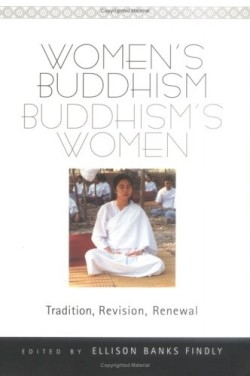Women's Buddhism, Buddhism's Women
Tradition, Revision, Renewal
In the essay, “Trudy Goodman: An American Zen Teacher,” the secret behind the successful Buddhist woman is perfectly summarized. She writes: “As women we need to feel our own power and mastery, not power over something, but the surge of trust and confidence in our own inner authority, in the wisdom of practice and experience.”
This book is filled with fascinating essays on Buddhism and all are focused on the traditions and changes that are taking place specifically for women in the spiritual, social, and political arenas.
There are five major sections that contain various articles about Ordination and Affiliation, Teachers and Lineages, Political and Social Change, Art, and Body and Health. Each author gives a different perspective on Buddhist women or nuns usually from a sect such as Burmese, Tibetan, Thai, Korean, and Western.
There are four areas of discrimination that Buddhist nuns experience that are repeated throughout the readings. In brief, they are: the teachings and practices for nuns are inconsistent with what the monks receive; there are stricter disciplinary rules for the women; titles and honorifics are curtailed for the nuns; and finally, there are fewer materials and donations for the women to subsist on versus what the monks are given.
Although these restrictions seem to have originated from eight principle rules passed down from the Buddha regarding women as nuns, the societies themselves struggle with the placement and treatment of these women as well.
The essays written from an individual’s personal life experience show a strength and transcendence that only a spiritual aspect can create and produces a foundation that does seem to be changing the way Buddhist women are viewed. As Bhikshuni Thubten Chodron says: “only when our own mind is peaceful can we clearly see methods to improve bad circumstances.” The difficulty arises as the ordained nuns struggle with the coming together of a new contemporary equality that also threatens the traditional society.
This book reflects a fascinating cultural spirituality where change can find its place in the deep rituals and traditions of Buddhism. His Holiness the Fourteenth Dalai Lama has opened the world of art, formally only monk-created, to women who, in turn, are sharing their work with the world. There is also an enormous amount of historical information available here. Much of the mystery of daily life in nunneries (and by comparison, monasteries) is revealed and the reader gains a fuller understanding of living as a Buddhist and what that means spiritually, physically, and socially.
In its entirety, the collection is inspiring to women in all walks of life, as it speaks to the fulfillment of personal desires and goals despite the obstacles of ingrained preconceptions and societal rules. At base, it is a book about perseverance, courage, and accomplishment.
Reviewed by
Aimé Merizon
Disclosure: This article is not an endorsement, but a review. The publisher of this book provided free copies of the book to have their book reviewed by a professional reviewer. No fee was paid by the publisher for this review. Foreword Reviews only recommends books that we love. Foreword Magazine, Inc. is disclosing this in accordance with the Federal Trade Commission’s 16 CFR, Part 255.

